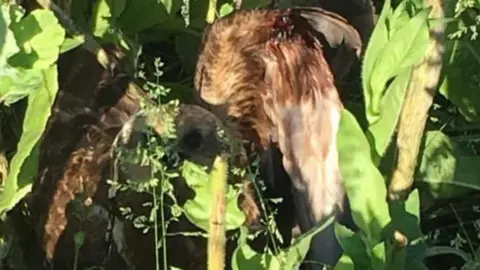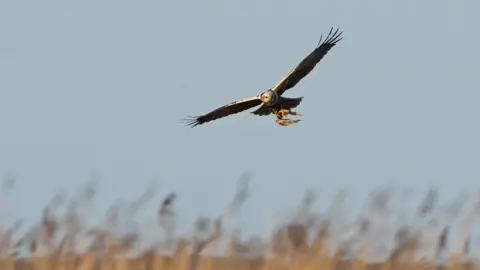Marsh harrier 'shot' near Norfolk nature reserve
 Hawk and Owl Trust
Hawk and Owl TrustA bird of prey thought to be part of a breeding pair on a nature reserve has been found shot, a wildlife group said.
The male marsh harrier was found injured by a dog walker at Sculthorpe Moor, near Fakenham, Norfolk, according to the reserve owner the Hawk and Owl Trust.
The find was reported to staff at the reserve, but when they got to the spot only a few feathers were left.
Since the find, a male bird breeding on the reserve has not been seen.
The Trust said this year's chicks were at risk because both parents were needed to supply enough food for their offspring.
 Getty Images
Getty ImagesThe Hawk and Owl Trust said it had reported the find, on 21 June, to Norfolk Police as the marsh harrier is a protected species under the Wildlife and Countryside Act 1981.
The trust said "the finder was unable to get to the bird to rescue, but did take a photograph which records the kind of injury that shows the bird had been shot".
Nigel Middleton, Sculthorpe Moor reserve manager, said: "Illegal persecution is such a problem and it's inexcusable. Having it happen on our doorstep has come as a real shock.
"Marsh harriers are the reason that Sculthorpe is a reserve. This is just horrifying.
"If anyone knows anything please let the police know. Let's bring this criminal to justice."
Norfolk Police said officers were "investigating reports of an injured marsh harrier found in Sculthorpe".

Marsh harrier
- Lives in marsh and reedbed
- Length: 52cm; wingspan 1.22m
- Breeds in Europe, central Asia and north Africa
- After nearly disappearing as a breeding species in Britain, it has recovered to about 400 breeding pairs, but still has "endangered" status
- Eats animals found/caught on the ground
Source: British Trust for Ornithology
